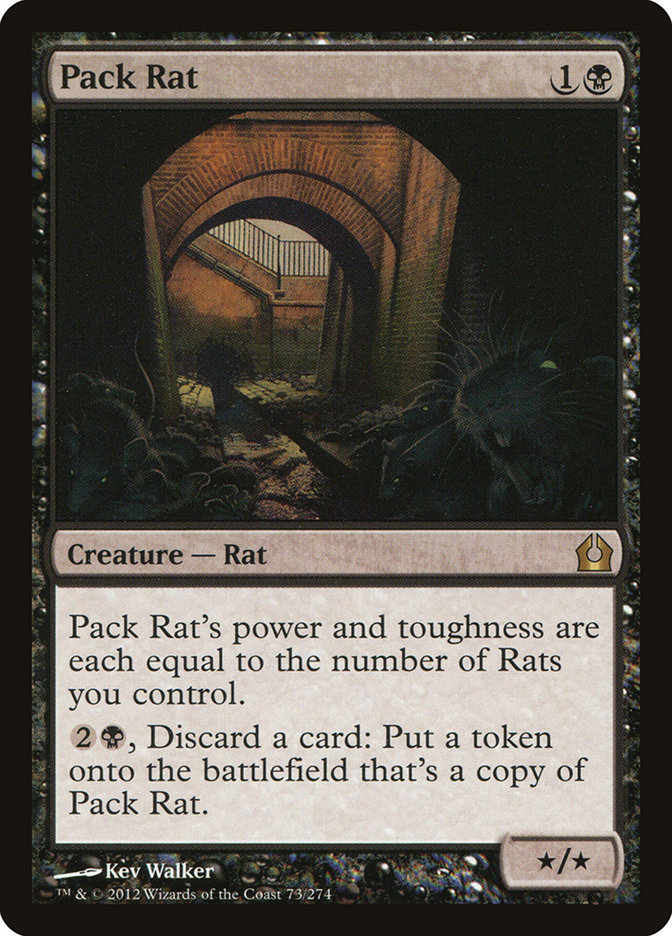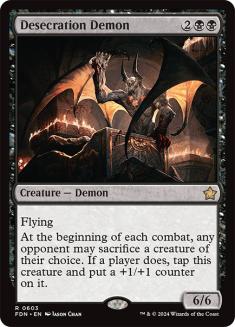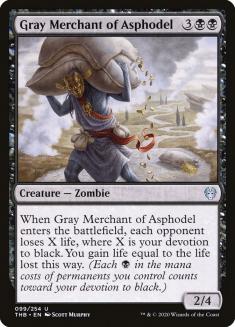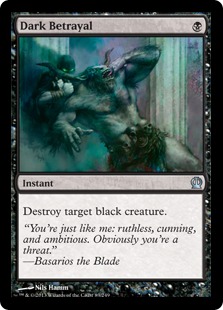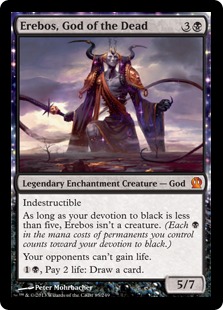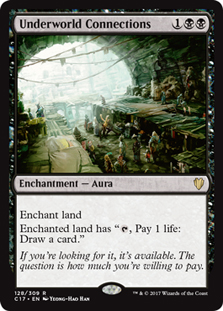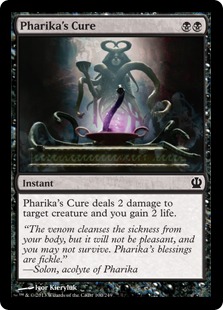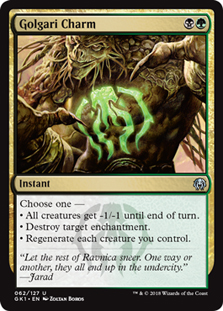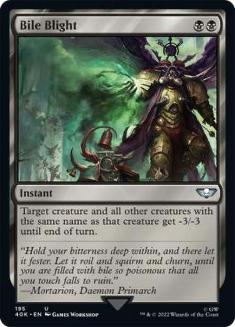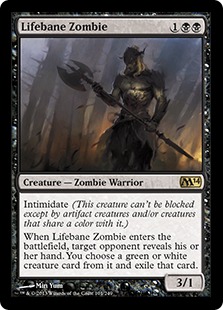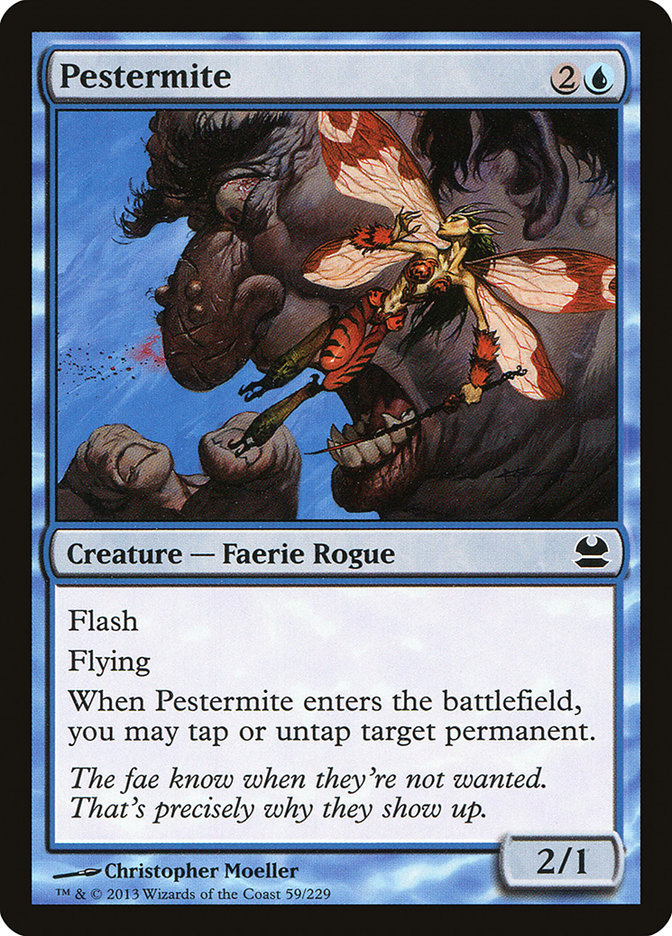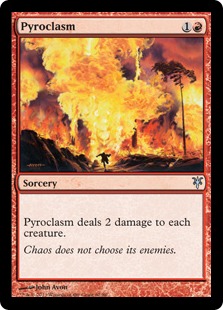Next weekend, many mages will be traveling across the United States to battle a few different formats. The Standard season is in full swing with Journey
into Nyx, but we must not forget about Modern! Grand Prix Minneapolis is approaching fast, and I’ve been playing a lot of Modern on Magic Online, because,
you know, the format is actually fun now. Without Deathrite Shaman stinking up the joint, boring old Jund decks aren’t nearly as good, and we have a lot of
room to work with. But we’ll get to that in a bit.
Standard with Public Enemy #1
First on the docket is Standard, and last week we traveled to Cincinnati for the StarCityGames.com Open Series. Journey
into Nyx is finally here, and we have our first results from the Standard Open that took place. The deck of the week?
It’s all your fault, Andrew Tenjum!
Creatures (16)
Planeswalkers (1)
Lands (25)
Spells (18)
Sideboard

Not again!
Well, actually, yes again, but you get my drift. I, for one, thought an influx of new cards, and potentially new hyper-aggressive decks, would push Black
Devotion to the side, leaving room for Blue Devotion and a host of other archetypes, but somehow Pack Rat just finds a way to ruin the party.
Much like Return to Ravnica Limited, losing to an opposing Pack Rat is a frustrating occurrence. In actuality, no one is having fun, as this “army in a
can” is just too powerful when combined with everyone’s favorite Minotaur tribal land: Mutavault. Yes, Pack Rat is a good card, but the rest of the deck is
just as good. If Pack Rat isn’t going to get the job done, then Desecration Demon and Gray Merchant of Asphodel come in and wreck up the place.
There doesn’t seem to be a specific deck that can really take down Black Devotion, and that is mostly due to the existence of this nightmarish reprint.
They reprinted Mutavault AND Thoughtseize? What did they expect? Pack Rat is just the new Bitterblossom, wherein you will get outclassed quickly if you
don’t apply enough pressure. The difference is that Bitterblossom was actually just an unreal win condition that didn’t force you to commit more mana or
cards to dominate a game. At least Pack Rat forces you to discard cards and use most of your mana every turn, though the Rat gets out of hand much
more quickly.
But enough about why we all hate Black Devotion. Let’s talk about why you should love Black Devotion. With all of the Temples from Theros block in
rotation, easy access to green mana gives you some new tools to work with. Abrupt Decay is a strong addition to the strategy, giving you answers to a host
of cards you couldn’t normally interact with.
Detention Sphere, Underworld Connections, and a few other annoyances were basically daggers given the right set of circumstances. The fact that there were
so few removal spells for two mana that could kill Nightveil Specter was also a pretty huge beating. Now, with Abrupt Decay, the Black Devotion decks have
a versatile answer to a variety of cheap threats and no longer have dead removal like Bile Blight against control decks.
One thing I’m not too keen on in Andrew’s deck is that he is pretty soft to Master of Waves. Yes, you have Abrupt Decay to interact with the early
creatures from Blue Devotion, but normally the two-drop slot usually killed Master of Waves too, giving you a reasonably number of answers for their couple
thousand elemental tokens. At this point, all we have in the maindeck is Hero’s Downfall, and that is just not a place I am happy to be.
I have a pretty big problem with Devour Flesh. I understand that it is one of your only ways to kill Blood Baron of Vizkopa, but it doesn’t actually see
all that much play. You also have four copies of Lifebane Zombie and Thoughtseize to keep it from hitting the board in the first place. I suppose that
Devour Flesh completes the safety net, but it seems like a lot of work just to make sure that Blood Baron doesn’t run rampant.
The upside to Devour Flesh is that, in a lot of matchups, using it on your own creatures can occasionally buy you enough life to survive an alpha-strike,
or potentially just provide you with a huge life barrier against a burn deck. There are times where Devour Flesh is actually just a much better card than
Diabolic Edict, but I’m not sold that it is better than having removal spells that can kill Master of Waves.
And what about an opposing Pack Rat?
Once Bile Blight was printed, I thought it was an unwritten rule that all black decks should play three copies of Bile Blight, just to make sure Pack Rat
didn’t get too out of hand in the mirror. Before Bile Blight, the mirror almost completely revolved around Pack Rat, and eventually Underworld Connections
once all the Pack Rats were dead. But even if you were ahead on cards thanks to Connections, there was a chance that your opponent could just peel Pack Rat
and end the game in a few turns.
Now don’t get me wrong, I think that Tenjum’s list was very good, and he played well enough to win the tournament. I don’t want you guys to think I’m just
jumping down his throat. But I want you to know that I think the deck can be built better, and is absolutely a deck you should be considering for the
Standard Open in Knoxville this weekend. I know I am, anyway.
Here’s what I’m probably playing this weekend in Knoxville, and how I would sideboard in the most important matchups:
Creatures (16)
Lands (26)
Spells (18)
Sideboard

With so much control running around at the moment, in all forms and flavors, I think that Nightveil Specter is exactly where you want to be. Lifebane
Zombie is a nice card when you’re battling against G/R Monsters or White aggressive decks, but he’s not exactly stellar outside of those matchups. He does
have three power, which is quite relevant, but Nightveil Specter has always been one of the best cards in any Black Devotion mirror, coming in right after
Pack Rat and Underworld Connections.
When everyone has access to Abrupt Decay in the Black Devotion mirrors, overloading them on threats that are important to hit with Abrupt Decay is exactly
what you want to be doing. I would much rather have them kill my Nightveil Specter than my Underworld Connections, where they can generally ignore Lifebane
Zombie until they get to a fairly low life total.
I also advocate trimming one copy of Hero’s Downfall in favor of another cheap removal spell. Since you aren’t playing straight Mono-Black, there is merit
to having your removal spells be cheaper, as you will have lands coming into play tapped or dealing damage to you. If you stumble at any point against a
fast draw from an aggressive opponent, it could be lights out.
I know that the there aren’t a significant number of changes, but I think they will be important for the decks I expect to face.
Now, let’s go over some of those matchups and figure out exactly what we want to be doing.
Black Devotion
Out:
In:
Desecration Demon is easily the worst card in the deck after board, as it can often come down too late to affect an early Pack Rat. It is also one of the
lowest impact cards when fighting an attrition battle, since it will always die for less mana than what you invest in it for very little gain. And even if
you connect with a Desecration Demon once or twice, that doesn’t actually do a whole lot.
The name of the game in the mirror is to kill everything, force them to discard their most important spells, and keep the engines running with Underworld
Connections. It will be a slugfest every single time, and generally ends when one person draws a Pack Rat later in the game and the opponent doesn’t have
an answer. The best way to keep that from happening is having cards that answer a variety of threats.
I’m ecstatic that all of our removal spells can kill Nightveil Specter, but that may not be much of an issue if everyone keeps on playing Lifebane Zombie
instead. In that regard, we will have a significant advantage in the matchup. They will be forced to leave in Desecration Demon, siding out Lifebane Zombie
instead, giving us a three-drop threat that they must deal with or just get buried in card advantage.
While not all flavors of Black Devotion (or Black Control) will be the same, you can adjust your sideboarding strategy based on what you see from them. If
they have Blood Baron and Obzedat over Gray Merchant of Asphodel, then Lifebane Zombie can come in over the last three copies of Gray Merchant. He isn’t
all that spectacular when most of your relevant board presence is immediately dispatched or discarded.
Blue Devotion
Out:
In:
The fact that Golgari Charm can kill Bident of Thassa is huge, as Bident is one of their best cards against you. It also does double duty against Master of
Waves in a pinch, but overall it is pretty narrow. There will be some points where they will pump their Frostburn Weird into a 4/1, allowing you to kill
it, but that won’t happen all that often. Golgari Charm does gets better if they’re splashing for Detention Sphere, though.
Pack Rat is not a terrible card in the matchup, but I find myself just trying to kill every creature they play. They have so many threats that you rarely
have time to get Pack Rat online and actually beat them with it. If they’re playing Cyclonic Rift or Detention Sphere, this plan is much harder to get
online.
I find that most games I win against Blue Devotion involve killing their first two creatures and then sticking a Desecration Demon. When that happens, the
path is pretty easy to find. However, there are games where they can beat you on card advantage, and you must rely on Underworld Connections, Nightveil
Specter, and Gray Merchant to finish them off.
This is as close to a 50/50 matchup as I have ever played, and will mostly come down to mulligan decisions or who draws better than the opponent. If you
make a mistake, it will cost you greatly, but the same can be said for them. Sequencing their spells correctly is crucial, and if they misstep, they will
give you a window to resolve a big threat and start crunching down on their life total.
U/W Control
Out:
In:
In Game One, Pack Rat is absurd. You have a lot of mediocre removal that can be discarded and turned into actual threats, though you must still battle
through Supreme Verdict and Detention Sphere. After sideboard, Pack Rat loses importance because you have fewer dead cards that you want to discard.
The tough thing about boarding in this matchup with the green splash is that Abrupt Decay has significant value thanks to them having Detention Sphere and
possibly Banishing Light. Underworld Connections is one of your most important cards, so keeping those active is huge. Golgari Charm can also add pressure
to their Detention Sphere effects, but also gives you a sweet bonus mode against Supreme Verdict if you have an army of Pack Rats or Desecration Demon
beating down.
Normally I am a fan of siding out all of my removal and bringing in more threats like Lifebane Zombie, but in this version I am actually siding out
threats. This means the matchup is probably a bit better, as Lifebane Zombie isn’t exactly an all-star against a deck without creatures, but a body is a
body.
G/R Monsters
Out:
In:
If G/R Monsters starts to rise again in popularity, I don’t recommend playing this version of the deck. We don’t have any copies of Doom Blade, as this is
a highly metagamed version of Black Devotion. Of course, the numbers could be tweaked to have a better matchup against this deck, but I would rather focus
on strategies that are more common.
I am aware that a reasonable number of people, including Brian Braun-Duin and Chris VanMeter, played Monsters in Cincinnati, but only one copy broke into
the Top 8 of the tournament, and it ultimately finished in 8th place. I am not implying that Monsters is a bad deck, but it honestly didn’t gain a lot from
Journey into Nyx, leading me to believe that it will not be something people actually want to play with.
Domri Rade is still a fantastic threat for midrange and control strategies to deal with, but this version of the deck can actually kill it thanks to Abrupt
Decay. Unfortunately, Bile Blight kills exactly Elvish Mystic out of the deck, so our removal package is pretty narrow against them.
My advice: scrap that matchup and move on. If you play against them, cross your fingers and play your best. Thoughtseize and Desecration Demon are still
tough for them to beat, but you will probably need to get a little lucky to win.
Red Aggro
This matchup will be difficult to sideboard in, because these decks can be built a number of ways. For the most part, Pharika’s Cure will be fantastic
against any build, as basically every version has Mutavault or some other juicy target. The life-gain aspect is huge here, but won’t win you the game by
itself. It just buys you enough time to find cards like Desecration Demon and Gray Merchant to beat them.
This is another matchup where Nightveil Specter is miles ahead of Lifebane Zombie, as the three points of toughness and flying are crucial against
Chandra’s Phoenix. It doesn’t do a great job of pressuring them, and also still dies to Lightning Strike, but that just means they aren’t progressing their
board. I would much rather have a three-drop creature that can block Ash Zealot!
If they are a burn-based deck, then Duress will be key. Thoughtseize is still reasonable, generally buying you a point or two of life, but it is a terrible
draw later in the game. Duress is almost always great, though.
The key point here is that you just need to figure out which version of the deck they are on before you know what you should sideboard in. Removal is great
if they have a ton of dorks like Burning-Tree Emissary, but worse if all they have is Chandra’s Phoenix. For the most part, Thoughtseize, Pack Rat, and
Underworld Connections are your worst cards.
Modern Architecture
Grand Prix Minneapolis is an event that I’m sad to be missing, but I do have some updates on the deck I played at Grand Prix Richmond.
Creatures (15)
Lands (22)
Spells (23)

If you have never played Splinter Twin before, here’s how it works:
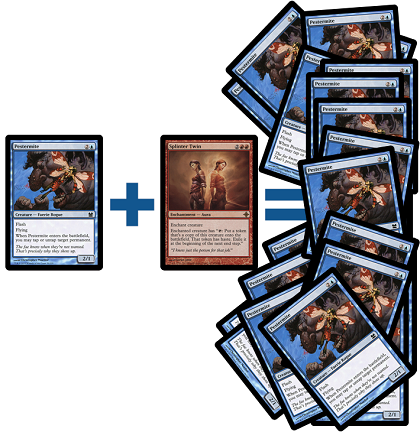
If you are looking for a deck to play in Minneapolis, I would highly recommend RUG Twin. For the most part, your deck plays out like a tempo-based
Tarmogoyf deck. You have cheap disruption with Remand, as well as cheap removal with Lightning Bolt and Flame Slash, all wrapped in a tight little bow with
Snapcaster Mage. You will win a lot of games by attacking with Tarmogoyf.
But Modern is full of “unfair” decks that try to beat you without using the attack step, and those decks are just jerks, so we have to stoop to their
level. That’s where the Splinter Twin combo part comes in. There are some draws with RUG Twin where you just kill them on Turn 4, because they tap out on
their turn like a big dummy, and you like taking free wins in a format that is incredibly skill intensive.
The most fun you have with the deck comes after sideboarding, where your opponent will almost always have some huge number of cards to sideboard in to
disrupt your combo. This is when Tarmogoyf and Snapcaster Mage will shine.
In fact, I generally board out almost all of my combo pieces aside from 2-3 Pestermites, assuming my opponent is also trying to play fair. You might want
to let THAT sink in for a second.
I’ve wrote a pretty extensive piece on RUG Twin after Grand Prix Richmond a few months ago, where I took ninth place out of what I think might have been an
actual billion people, which you can find here.
Here, I’ll go over the changes and why I think they’re necessary.
I upped the count on Pestermite to four and downed Deceiver Exarch to two because of how easily the deck transitions to beatdown. With Pestermite acting as
a real threat in a number of scenarios, it seems only natural to want more copies of it than Exarch. The only upside to Exarch is that it doesn’t die to
Lightning Bolt, which is commonly played, but I would much rather have my alternate gameplan actually work instead of drawing a Horned Turtle.
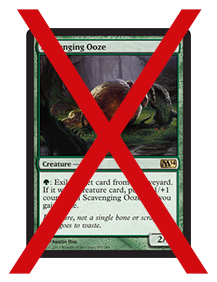
Scavenging Ooze was never impressive for me in the deck. We are basically “splashing” green, and that makes activating Scavenging Ooze quite difficult.
While Vendilion Clique costs a bit more than Scavenging Ooze, the effect is fantastic whether you target your opponent, or even yourself! I can’t tell you
how many times I get to throw away an extra copy of Splinter Twin and replace it with a fresh card. It feels so good.
I wanted to add one more card that is awesome against both Affinity and Melira Pod, but Anger of the Gods often costs too much red mana or too much
physical mana to cast in a timely manner. Having a singleton Pyroclasm to help out is nice, and gives you some help against a few other matchups (like B/W
Tokens).
Other than that, there isn’t a whole lot to be said. Threads of Disloyalty wasn’t nearly as good as I thought it would be, though it is possible that
having a singleton copy is worth it. The biggest struggle in Modern is having the perfect 75 for each tournament, as that changes constantly. With so many
cantrip effects, digging through your deck for specific answers isn’t all that difficult, so a single change to the sideboard could mean all the
difference.
I think that a generic sideboarding guide for this style of deck is virtually impossible. I change how my deck operates on the fly in nearly every match
based on what I see out of my opponent’s deck. If the combo seems like it would be good, then I leave it in. Otherwise, I side it out and bring in more
removal and specific hate-cards. You can really mess with your opponent with this kind of deck, keeping them guessing until the very end, so be creative!
After all, that’s what Modern is all about!

